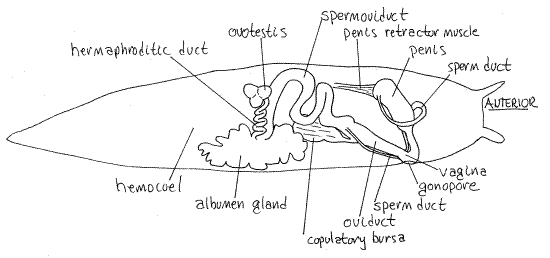Before we begin this series, we need to first discuss how slugs mate. In explaining the mating process, I will be consulting Terrestrial Mollusc Tool for the fact sheet on Lehmannia valentiana, as well as Richard Fox's notes on the dissection of Limax maximus, and, most importantly, Heike Reise's article, A review of mating behavior in slugs of the genus Deroceras. More of her research can be found here:
http://www.senckenberg.de/files/content/forschung/abteilung/zoologie/malakologie/malak/reise/reise.htm#contents.
Though the last two references deal with other genera of slugs, I will integrate that information with my own observations of this particular species.
Reproduction in slugs is sexual, although there are cases of self-fertilization. Slugs are hermaphrodites, meaning that they possess both male and female sex organs. Young slugs may begin as males, developing the female organs later on.
 |
| The basic anatomy still applies to Lehmannia valentiana. © 2001 Richard Fox, Lander University |
 |
| "The appendix on the penis of this species is somewhat tubular or the apex may appear expanded." Photo: © R. Forsyth, modified by K. Weigel, University of Florida |
In fully hermaphroditic adults, mating is conducted with both penes. Mating behavior varies both intra- and interspecifically. Basically, after successive phases of precourtship (investigating with tentacles, nibbling mucus on bodies, trail-following) and courtship (circling each other and extruding the excitatory organ towards each other), copulation occurs as each slug everts its penis from its gonopore (the sexual pore, protected by the mantle) and, depending on the species, either intertwines it with its partner's penis, or inserts it into its partner's gonopore (known as intromission). Both methods facilitate the mutual exchange of sperm. Species such as Deroceras invadens are quite aggressive during courtship, lunging and biting at each other. Following copulation, the slugs enter a withdrawal phase, also with its own behavioral characteristics. Because they are hermaphrodites, each slug is capable of both giving and receiving sperm, and consequently of laying eggs.
 |
| © 1995, 2006 Heike Reise |
I am still uncertain as to whether mating in Lehmannia valentiana involves external intertwining or simultaneous intromission. At first the penes seem to be intertwined, but then the slugs close their bodies around the organs, concealing them from view. Normally, species that engage in external sperm exchange do so with their penes in plain sight, either held between their circled bodies if on a horizontal surface or dangling below their heads if on a vertical surface. In addition, the penial gland (an organ with finger-like extensions, presumably used to secrete a substance on the partner's body) should emerge following copulation; I have never seen this organ everted in Lehmannia valentiana.
After everting the penes, which happens suddenly and briefly, the slugs of Lehmannia valentiana continue to intertwine their bodies, rubbing against each other. As I can't watch every angle, since mating usually takes place on a wall or other flat surface, I don't know whether these movements are related to the actual sperm exchange, or whether that has been concluded and this is part of the withdrawal phase following copulation. I've noticed that precourtship, courtship, and withdrawal can take several minutes, while the actual copulation can be quite brief. Sometimes I have to hurry to get a shot at all. This separates Lehmannia valentiana from other species in that the entire mating process in the latter can last for hours. (This observation is confirmed by http://www.animalbase.uni-goettingen.de/zooweb/servlet/AnimalBase/home/species?id=2637). In a way I'm glad, because if I had to observe my slugs that long, sitting out there in the cold, damp night, I'd probably contract pneumonia.
Anyway, I hope these notes have given you an overview of the mating behavior of Lehmannia valentiana. If you have any questions, I will try to answer them in subsequent posts. Moreover, I will show evidence both for and against the hypothesis that Lehmannia valentiana engages in external intertwining like other species. If I arrive on the scene early enough, I'm usually able to chronicle each instance of mating as early as precourtship, so I will add extensive descriptions to accompany the photos, identifying each phase. Also, later on I will address the theories among malacologists (zoologists who specialize in molluscs) that hermaphroditism among slugs results in role conflicts (i.e. slugs reluctant to participate in mutual sperm exchange, preferring to act as female or male, also mating more than once, hormone manipulation, and apophallation). I'll discuss the theory and bring my own observations to the table.
No comments:
Post a Comment